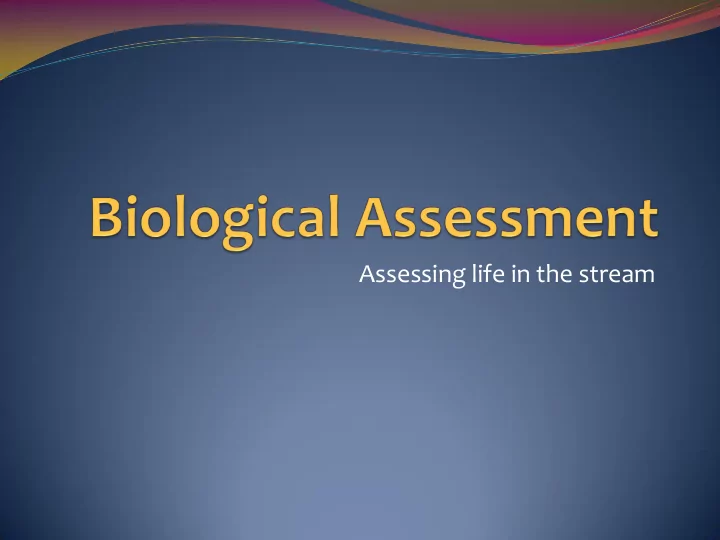

Assessing life in the stream
Aquatic Plants More plants = more diversity Hard to identify Pollution tolerance unknown Record in “Other” 2
Aquatic Plants Algae Record in “Other” Lots of algae = nutrient enrichment 3
Benthic Aquatic Macroinvertebrates Benthic - bottom dwellers Aquatic – live in water Macro - large Invertebrates - without backbone 4
Macroinvertebrates Do not migrate far Easy to collect and identify Known tolerance levels- “Environmental thermometers ” 5
Critter Collection Frequency No more than 3 times/year Spring, Summer and Fall Methods: Collect Sort Identify Record 6
Critter Collection Survey as many micro-habitats as possible! 7
Indicator Groups Group 1 Taxa: LOW pollution tolerance= Only high quality H2O Group 2 Taxa: MEDIUM pollution tolerance = Mid – high quality H2O Group 3 Taxa: HIGH pollution tolerance = Low - high quality H2O 8
LOW pollution tolerance Stonefly – shredder 9
LOW pollution tolerance Caddisfly – shredder 10
LOW pollution tolerance Mayfly – grazer 11
LOW pollution tolerance Riffle beetle
LOW pollution tolerance Water penny beetle Snail (not pouch) 13
MEDIUM pollution tolerance Damselfly Crane fly Dragonfly Scud 14
MEDIUM pollution tolerance Crawdad Alderfly Mussels/Clams Sowbug 15
HIGH pollution tolerance Midge fly Pouch snail Flatworm Black fly Aquatic worm Leech 16
Fish 17
Special event sampling 18
Snapshot Sampling Occurs twice a year Spring Fall $10/sample for Nitrate, total Phosphorus, total coliform and E. coli 19
Snapshot Procedure Register for Snapshot online Sample bottles will be sent out Samples must be: Collected on day of Snapshot Kept cool during transport Returned by time indicated All samples will be analyzed at UI Coeur d’Alene water lab Assistance in lab welcome 20
Bacteria Test for Total coliform bacteria E. coli Results in Most Probable Number per 100 mL of sample water (MPN/100mL) 21
Identification and Prevention
Transport by Boats and Gear Invasive plants and animals are one of the most significant threats to our lakes and rivers Choke out waterways Disrupt water transfer, and increase power generation costs Outcompete native species Disrupt aquatic ecosystems 23
Invasive Species Prevention To prevent the transport of invasive species: Clean : all mud and plant material from sampling equipment Drain : all standing water from boats and sampling equipment Dry : all surfaces and compartments to prevent the movement of invasive species 24
Eurasian Watermilfoil 25
New Zealand Mudsnails 26
Zebra & Quagga Mussels 27
Zebra and Quagga Mussels 28
For more information on invasive species: Idaho Department of Agriculture: www.agri.idaho.gov Mussel Information: www.100thmeridian.org USGS Invasive Species Program: www.usgs.gov/ecosystems/invasive_species/ 29
Questions? 30
Recommend
More recommend